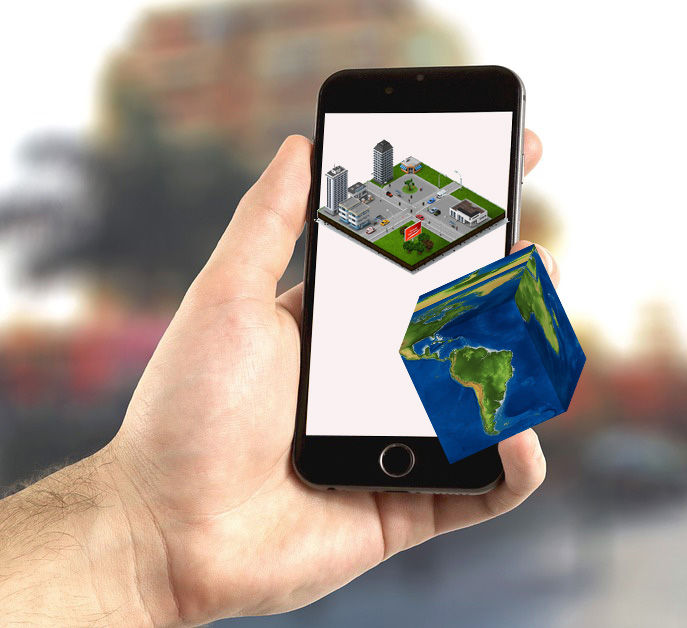
If there’s one thing that government has a lock on, it’s data!
The information that government is required to collect, protect and preserve is massive and diverse. It covers almost everything – student school records from kindergarten through college, every imaginable type of crime statistic, licensing and permitting records, medical records, social program participation, purchasing data, inventory records…and more. And, the data is not only extremely valuable if managed well, but it is also destined to change many aspects of how government functions.
To their credit, public officials have tried for years to manage and use data to improve public safety, traffic congestion, student achievement and a better quality of life for citizens. That objective is now being aided by a leading-edge technology.
Augmented Reality (AR) is being called “the next best thing” in technology circles and public officials are scrambling to get it. Augmented reality, not to be confused with virtual reality, is a way to layer virtual information over collected data and present a quick overview of everything known about a location. Think about a situation where a first responder is standing on a cliff trying to escape a raging fire. With augmented reality, the user could see a pop-up overlay of data that shows the height of the cliff, the depth of the water below and where rocks are located under the water.
Using AR technology, public safety employees can dispatch first responders to a crime scene, a building fire or a subway disaster and then provide every bit of information available about the location. By simply pointing a smartphone at any location, first responders are able to pull up images and immediately see layers of data and visuals. Information about buildings, 3D floorplans designating entrances and exits, the location of gas lines and even crime statistics in the neighborhood can be checked quickly.
 During weather events such as floods or tornadoes, government officials can see data about traffic congestion or flooded or impassable streets and locate the environments around schools, hospitals, etc. AR can also be used to display where power outages are reported and point out the quickest and safest routes for service and emergency vehicles to access the area. The data can be displayed on smartphones or tablets or on head-mounted displays, windshields or other visual enhancement devices such as goggles or eyeglasses. The pictures and data can save lives.
During weather events such as floods or tornadoes, government officials can see data about traffic congestion or flooded or impassable streets and locate the environments around schools, hospitals, etc. AR can also be used to display where power outages are reported and point out the quickest and safest routes for service and emergency vehicles to access the area. The data can be displayed on smartphones or tablets or on head-mounted displays, windshields or other visual enhancement devices such as goggles or eyeglasses. The pictures and data can save lives.
The U.S. Air Force recently issued a request for information (RFI) for virtual, augmented and mixed reality (VAM) technologies for aircraft maintenance. The Air Force wants to end the use of printed instructions for maintenance of aircraft. Instead there is a desire to explore ways to project visualizations of the instructions for quicker repair. A technician might be wearing smart glasses and see animation of the steps for repairs on the machine being repaired. The RFI notes that in the manufacturing industry, AR projected work instructions as opposed to paper manuals have resulted in a 90 percent reduction in repair quality errors not to mention the time saved because everything is stored in one large data bin.
Two groups of firefighters from Menlo Park and Alameda County were among the responders fighting recent wildfires in California and taking advantage of drone technology. The drones were equipped with AR software that allowed the tracking of all firefighters. AR provided video coverage that was transmitted to officials who were managing the firefighting effort of the entire area.
Drones with AR software were also used to produce augmented aerial views of Miami and the Florida Keys during Hurricane Irma last year. The augmented reality technology provided visuals of street grids and helped first responders prioritize relief areas and then reach areas of the city that were flooded.
Alameda County’s use of AR technology is not limited to improving its firefighting efforts. The county has also developed apps for various city departments, aimed at improving workflow and efficiencies. The AR program allows city employees to oversee some building maintenance responsibilities without having to physically go to the site. AR allows them to determine things such as when a building was last inspected or what types of light bulbs are used in certain facilities.
Providing instantaneous information on demand is the goal of augmented reality and government is embracing the technology with gusto. Citizens throughout the country will likely have an opportunity in the very near future to also engage with an augmented reality program. This trend is moving at warp speed… so watch for it!
